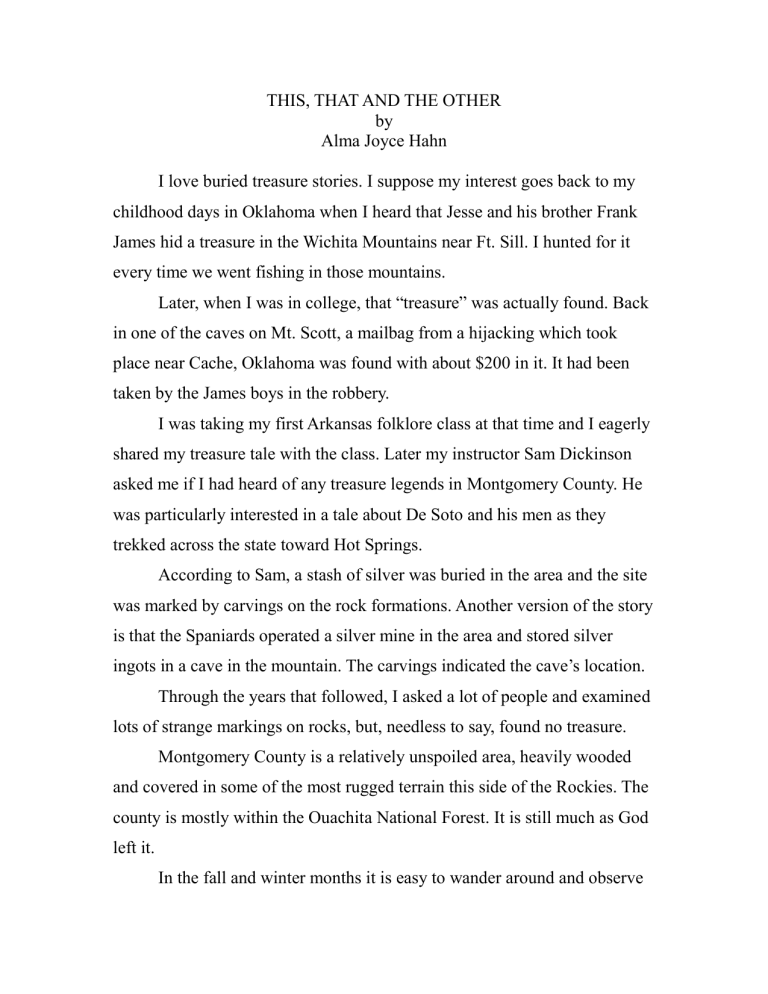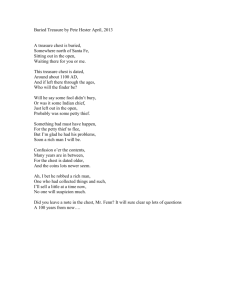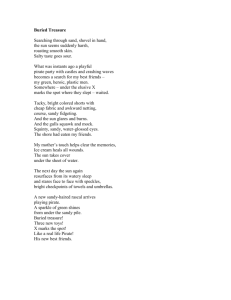THIS, THAT AND THE OTHER

THIS, THAT AND THE OTHER by
Alma Joyce Hahn
I love buried treasure stories. I suppose my interest goes back to my childhood days in Oklahoma when I heard that Jesse and his brother Frank
James hid a treasure in the Wichita Mountains near Ft. Sill. I hunted for it every time we went fishing in those mountains.
Later, when I was in college, that “treasure” was actually found. Back in one of the caves on Mt. Scott, a mailbag from a hijacking which took place near Cache, Oklahoma was found with about $200 in it. It had been taken by the James boys in the robbery.
I was taking my first Arkansas folklore class at that time and I eagerly shared my treasure tale with the class. Later my instructor Sam Dickinson asked me if I had heard of any treasure legends in Montgomery County. He was particularly interested in a tale about De Soto and his men as they trekked across the state toward Hot Springs.
According to Sam, a stash of silver was buried in the area and the site was marked by carvings on the rock formations. Another version of the story is that the Spaniards operated a silver mine in the area and stored silver ingots in a cave in the mountain. The carvings indicated the cave’s location.
Through the years that followed, I asked a lot of people and examined lots of strange markings on rocks, but, needless to say, found no treasure.
Montgomery County is a relatively unspoiled area, heavily wooded and covered in some of the most rugged terrain this side of the Rockies. The county is mostly within the Ouachita National Forest. It is still much as God left it.
In the fall and winter months it is easy to wander around and observe
the surroundings, and I often did so. I frequently noted strange markings on rocks and trees. I examined them carefully. Were they natural or man-made?
Indians had lived and hunted in the area for generations. Did they make them?
Of course I outgrew such adventures, but I never forgot them. My interest in these “clues” was reactivated recently as I began reading about the lost gold of the Confederacy.
According to the stories, at the end of the Civil War, Jefferson Davis,
President of the Confederacy, ordered the remaining funds that had been advanced by France and other European countries when the South seceded from the Union to be turned over to the Federal forces. Stories vary, but it seems that there was about $500,000 at the time.
Not much by today’s standards, but a considerable amount then. If those funds were found today, they would be worth much, much more.
The money never reached its destination and stories abound about what happened to it and to other purported funds raised by pro-slavery forces. The Masons and the Knights Templars are thought to have been involved. (They are accused of everything when it comes to treasures.)
Another group, of which I know little about, seems to be more involved in the theft of the money. They are the KGC--the Knights of the Golden Circle.
The KGC was organized to promote the Southern interests before and after the Civil War. They had high hopes of uniting a number of neighboring countries into a strong slave-holding nation. (The organization later became the Order of the Sons of Liberty, but we’ll stick with KGC.) Interestingly the
James brothers were purported to have been strong in the organization, as was Albert Pike, among others.
According to tales, The KGC divided up the treasure into smaller
shares of money with instructions to take the money and bury it in designated areas, leaving clues in a sort of secret code. Later, when the times were right they could reclaim the money and the South could “rise again.”
Many states claim to have some of the fortune buried there. Arkansas, namely Montgomery and Polk Counties, is rumored to hide a big part of the wealth. Some of it may even have been found.
There is a man named Bob Brewer who lives in the little Polk County town of Mansfield who thinks he has figured out where some of the gold is hidden. Brewer is a descendant of one of the Confederate members of the
KGC who was sworn to protect the original treasure.
Brewer served in the U.S. Navy and returned to Arkansas when he retired. He worked in the woods with an uncle who was always noting strange markings and carvings on rocks, old tree trunks and other places where a sort of code might be inconspicuously located, but easy to spot if you knew what you were looking for.
Later Brewer began mapping the locations of such markings that he found in the woods. Soon he developed a logical arrangement of these signs.
He would dig in the earth at these locations. He would often find metal pieces from tools or household items buried there. He concluded that these were deliberately left there for some reason, perhaps as markers of some sort.
Time passed and he and his family became discouraged. Then he hit pay dirt. He found a fruit jar full of coins. Not much, but he knew he was onto something; his system was working.
Since that time Brewer has found other stashes of treasure. He now feels he has the knowledge of the “system” to find more.
Arkansas is not the only state where it is thought that Confederate
gold may be buried; many states have such tales to tell.
Got a hankering to go treasure hunting? The national forests of
Arkansas are as good a place as any to start.
Contact Alma Joyce Hahn at beajhahn@sbcglobal.net
962 words








